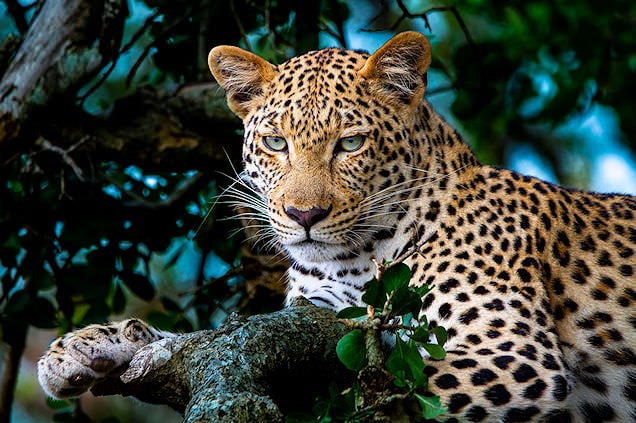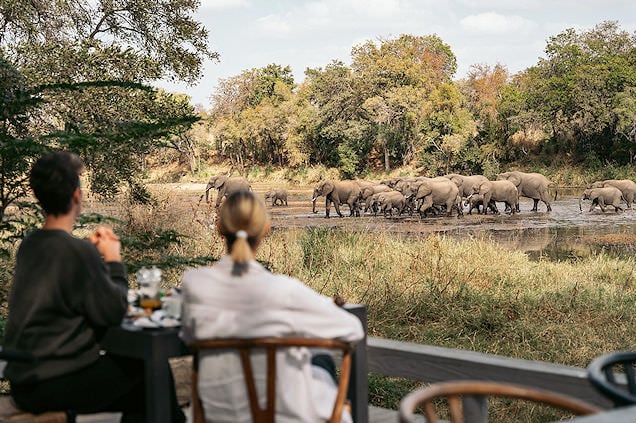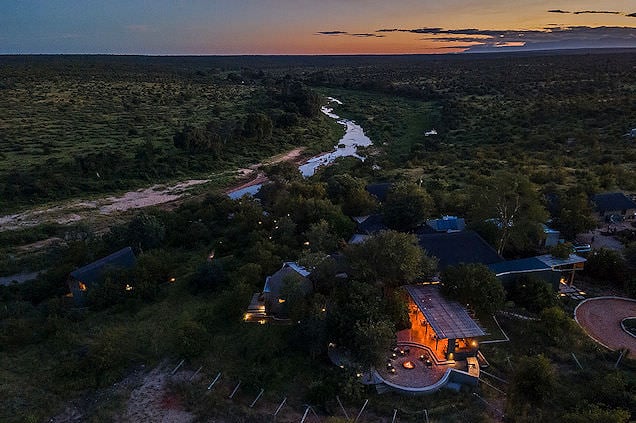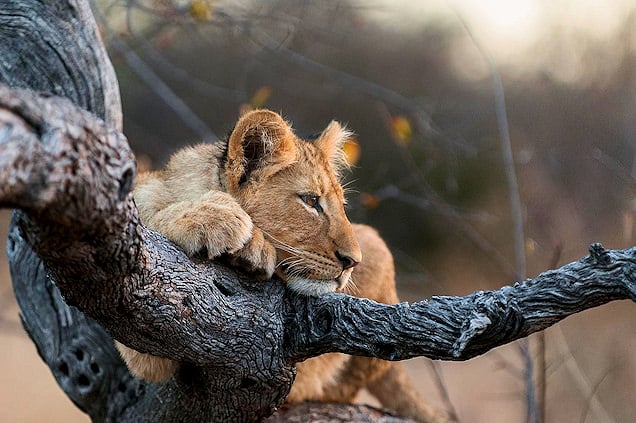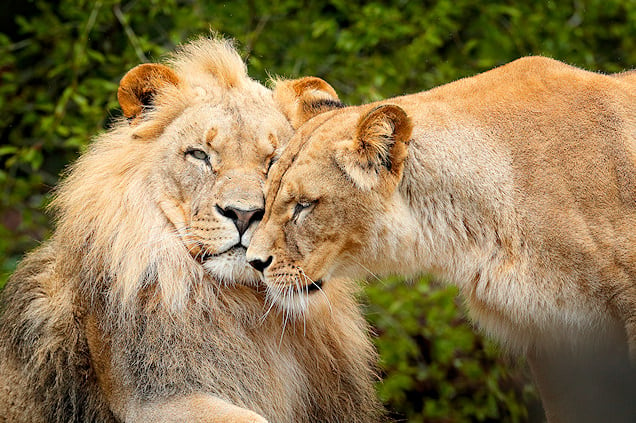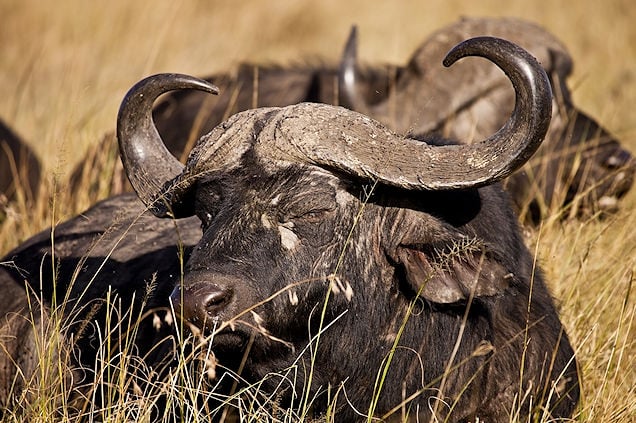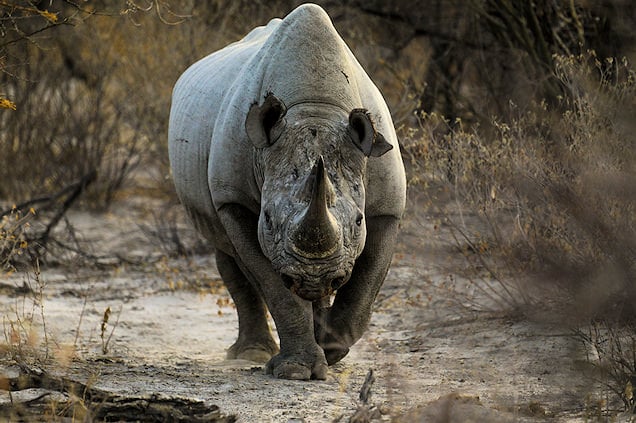Kruger National Park Travel and Vacations
Help Me Plan- Home
- >
- African Travel
- >
- South Africa
- >
- National Parks
- >
- Kruger National Park
Kruger National Park Destination Guide
The Kruger National Park is South Africa’s flagship conservation area and one of the most celebrated safari destinations on the continent. Spanning nearly two million hectares, it shelters exceptional biodiversity, from the iconic Big Five to hundreds of bird and plant species. Visitors can explore its landscapes on African Sky’s privately guided overland safaris or luxury fly-in safari packages, with accommodation options ranging from simple rest camps to world-class private lodges.
Getting There
Three airports serve the Kruger National Park: Kruger Mpumalanga International (MQP) and Skukuza (SZK) in the south, and Hoedspruit/Eastgate (HDS) in the central region. Scheduled and charter flights are available to most private lodges. Flight duration from Johannesburg typically ranges from about 50 minutes to 90 minutes.
Traveling overland from Johannesburg to the southern and central Kruger National Park involves between four and six hours. We recommend that overland visitors enter via Malelane, Crocodile Bridge, Paul Kruger, Phabeni, Orpen, or Phalaborwa gates.
Weather & Best Time To Visit
Spring and summer in Kruger can be very hot, with maximums often in the low to mid-30s °C. The malaria risk is also higher during the rainy months.
The best wildlife viewing is typically during the dry autumn/winter period between April and August when vegetation thins and animals concentrate near water sources. Average winter daytime highs range from the mid-20s to upper-20s °C, with cool mornings and nights.
Medical Considerations
Kruger lies in a malaria area. All visitors should consult their healthcare provider regarding chemoprophylaxis and personal protection measures before travel.
Safety
Close encounters with wildlife can be intimidating. You can rely on experienced rangers with in-depth knowledge of animal behavior. Though rare, incidents have occurred in the broader region; adhere to ranger instructions and park rules at all times. Since 1998, no such incidents have occurred on any safari operated by African Sky.
Recommended Reading (Kruger National Park)
- Field Guide to the Mammals of the Kruger National Park – by Heike Schütze
- Roberts Bird Guide: Kruger National Park and Adjacent Lowveld – by Hugh Chittenden
- Make the Most of Your Visit to Kruger National Park – by Peter Klein
Web Resources
Essentials When Visiting Kruger
Safari enthusiasts have diverse accommodation and package options, catering to various budgets and interests.
An itinerary suited to your requirements is sure to be found.
Properties range from intimate luxury lodges to extravagant safari palaces.
National park camps offer comfortable accommodations on budget-friendly safaris.
Video and Facts
The sprawling two million-hectare park offers every opportunity for an unforgettable, rewarding game-viewing experience.
We've curated the most essential—and interesting—material for your convenience and pleasure.
Private Game Reserves
The private game reserves that form part of the Greater Kruger National Park are among the most popular luxury safari destinations in Africa. These reserves share unfenced borders with the park.
Sabi Sand is renowned for exclusive game viewing and top-tier lodges, ensuring a more secluded experience away from busy areas.
Timbavati offers expansive open plains, superb lodges, and occasional sightings of the region’s rare white lion.
Manyeleti, the “Place of the Stars,” neighbors Sabi Sand and Timbavati, with the Big Five and over 300 recorded bird species.
One of South Africa’s largest private reserves, Klaserie offers a tranquil atmosphere and authentic, low-density safari experiences.
Balule shares unfenced borders with Kruger, with diverse habitats—savannahs, woodlands, and riverine zones—supporting abundant wildlife.
Kruger National Park Vacation Options & Travel Tips
While Kruger National Park is the main safari attraction in Mpumalanga and Limpopo, trips can be customized to include scenic tours to nearby sites such as Blyde River Canyon and God’s Window.

Tours, Safaris & Honeymoons
Browse our thoughtfully crafted safari tours.

Tailor-Made Vacation Packages
All our tours and safaris can be customized.

Travel Tips & Advice
Important information about visiting Southern Africa.
For the Enthusiast
Here you will find information about some lesser-known activities, locations, and wildlife in Kruger.
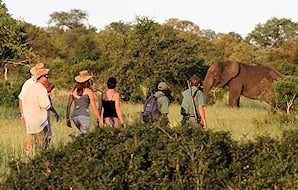
Hiking Trails
Various wilderness trails crisscross quieter regions where private vehicles are not allowed. You’ll spend a few days on foot, close to nature and learning more about the animals you encounter. Accommodation is basic but comfortable.
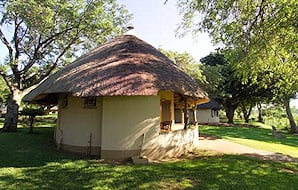
Satellite and Bushveld Camps
These rustic outposts trade luxuries for a more intimate encounter with nature. No restaurant or other facilities are available on site, so guests should arrive fully equipped.

Picnic Spots
Many casual picnic spots are scattered along Kruger’s main arteries. They’re ideal for pit stops or lunch while you are out game viewing with your African Sky guide.

Snakes of Kruger
Kruger is home to several snake species. Though many visitors dislike these reptiles, others are fascinated by their role in the ecosystem.
Home of the Big Five
Kruger Park is home to the Big Five and exceptional diversity of other animal species.
Elephant abound in Kruger National Park in large herds, and you are sure to encounter them on your safari—always an awe-inspiring sight.
Lion are among the most sought-after sightings, and witnessing a hunt is a highlight of any safari.
Buffalo may appear docile as they move in large herds, yet they have earned a reputation for strength and unpredictability.
Leopard are elusive, often resting in trees along rivers or secluded thickets—thrilling to spot even for seasoned visitors.
Black rhino are critically endangered. The Greater Kruger hosts a small, closely protected population.
Experience the thrill of a game drive
Game drives are the number one activity in Kruger National Park, and the place to witness spectacular wildlife encounters is from the seat of a safari vehicle. Guests depart at dawn, in the afternoon, or at dusk for an excursion into the wilderness lasting between two and three hours. Each drive is led by an experienced ranger, with open-sided vehicles providing maximum viewing and photographic opportunities. You’ll experience remarkably close encounters while the scents, sights, and sounds of the Lowveld fully awaken your inner explorer.

Foods To Try In Kruger
Visiting this wild corner of the continent means some adventurous dining options are available, which will appeal particularly well to meat lovers and curious eaters.

Game Meat
Game meat—including buffalo, kudu, and impala—is worth trying. It is generally on the menu at private lodges and restaurants in national park camps. Low in fat, it is also a healthy option.
Potjiekos
A slow-cooked stew made with ingredients popular in South Africa, this delicacy is frequently found at lodges and rest-camp restaurants.
Biltong
A South African staple. It is readily available throughout Kruger and can be purchased at most shops in the national park.
Braai
South Africans love a barbecue—or braai—especially on Heritage Day. At lodges in and around Kruger, you will almost certainly enjoy this local tradition.Kruger National Park FAQ
The following are published population estimates from 2011.
| Blue Wildebeest | 6,400 to 13,100 |
| Buffalo | 37,130 |
| Burchell's Zebra | 23,700 to 35,300 |
| Cheetah | 120 |
| Crocodile | 4,420 |
| Eland | 460 |
| Elephant | 13,750 |
| Giraffe | 6,800 to 10,300 |
| Greater Kudu | 11,200 to 17,300 |
| Hippopotamus | 3,100 |
| Impala | 132,300 to 176,400 |
| Leopard | 1,000 |
| Lion | 1,620 to 1,750 |
| Mountain Reedbuck | 150 |
| Nyala | >300 |
| Reedbuck | 300 |
| Roan Antelope | 90 |
| Sable Antelope | 290 |
| Spotted Hyena | 5,340 |
| Tsessebe | 220 |
| Warthog | 3,100 to 5,700 |
| Waterbuck | 3,100 to 7,800 |
| Wild Dog | 120 |
Entrance gates: January 05:30–18:30; February 05:30–18:30; March 05:30–18:00; April 06:00–18:00; May 06:00–17:30; June 06:00–17:30; July 06:00–17:30; August 06:00–18:00; September 06:00–18:00; October 05:30–18:00; November 05:30–18:30; December 05:30–18:30.
Camp gates: January 04:30–18:30; February 05:30–18:30; March 05:30–18:00; April 06:00–18:00; May 06:00–17:30; June 06:00–17:30; July 06:00–17:30; August 06:00–18:00; September 06:00–18:00; October 05:30–18:00; November 04:30–18:30; December 04:30–18:30.
Times may change without notice—confirm with the park before arrival.
| Gate | Phone Number |
|---|---|
| Crocodile Bridge | +27 (0)13 735 6012 |
| Kruger Gate | +27 (0)13 735 5107 |
| Malelane | +27 (0)13 735 6152 |
| Numbi | +27 (0)13 735 5133 |
| Orpen | +27 (0)13 735 0237/0238 |
| Pafuri | +27 (0)13 735 5574 |
| Phabeni | +27 (0)13 735 5890 |
| Phalaborwa | +27 (0)13 735 3547 |
| Punda Maria | +27 (0)13 735 6870 |
In Kruger Park, there are demarcated areas where visitors can disembark vehicles. At private lodges, rangers stop for morning coffee and for sundowner drinks—excellent opportunities to stretch your legs.
Wild animals are inherently dangerous. If you follow the rules and instructions of your ranger, you will be safe.
Poaching is a problem. It is highly unlikely that you will come into contact with poachers, as they avoid areas frequented by tourists.
Kruger lies in a malaria area. Consult your healthcare provider about malaria prophylaxis and use personal protection (repellent, long sleeves, nets).
If you stay at a lodge, late-afternoon game drives often run into the first hours of darkness. When staying at a national park camp, you can book a night drive accompanied by local rangers.
Most lodges provide personal safes in each room. In national park camps, keep accommodation locked; if you do so, your belongings should be safe.
Yes, but bottled water is also available throughout the park.
Visa, Mastercard, and American Express are widely accepted at lodges and at shops and restaurants in main camps.
South African rand (ZAR). Some private lodges may accept major foreign currencies, but conversion rates are typically unfavorable; change some currency to rand on arrival.
Most main camps have mobile coverage, but service can be limited away from camps. Some private lodges provide complimentary Wi-Fi; availability at SANParks camps varies—confirm when booking.
Mammals & Birdlife

Legendary Mammals
Kruger National Park is an excellent arena for close encounters of the four-legged kind. It is a haven where endangered and vulnerable species—such as African wild dog, black rhinoceros, and cheetah—still roam in their natural habitat. The big cats prosper, and the chances of seeing lion and leopard are among the best on the continent.
Elephant occur in abundance, and white rhino are present in smaller numbers. Large herds of African buffalo often darken the savanna as they emerge from the bush in their thousands.

Other Species
Large herbivores such as Burchell’s zebra, blue wildebeest, giraffe, kudu, waterbuck, and impala are common, while eland, nyala, and smaller antelope are less frequently seen. Lesser mammals include spotted hyena, black-backed jackal, honey badger, genet, meerkat, mongoose, warthog, bushpig, porcupine, baboon, and vervet monkey. Dams and rivers teem with hippo and crocodile.

Birdlife
With over 500 recorded species, Kruger is a birder’s paradise. From the lilac-breasted roller to the Bateleur eagle, visitors will be charmed by the kaleidoscope of birdlife. The park’s “Big Six” birds include lappet-faced vulture, martial eagle, saddle-billed stork, kori bustard, southern ground hornbill, and the elusive Pel’s fishing owl.
History
Sabie Game Reserve
In 1898, the initiative of Jakob-Louis van Wyk, R.K. Loveday, and President Paul Kruger to establish a government wildlife park led to the proclamation of the area between the Sabie and Crocodile rivers as the Sabie Game Reserve. This area now comprises the southern third of the modern park. The first official warden, Scottish-born Major James Stevenson-Hamilton, was appointed by Sir Godfrey Lagden in 1902. Harry Wolhuter and Thomas Duke became the Sabie Game Reserve’s first rangers, posted at present-day Pretoriuskop and Lower Sabie, while Stevenson-Hamilton operated headquarters at the Sabie Bridge (present-day Skukuza).
Shingwedzi Game Reserve
In 1903, the Shingwedzi Game Reserve (now part of northern Kruger) was proclaimed and added to Stevenson-Hamilton’s responsibilities. He appointed Major A.A. Fraser as the reserve’s first head ranger in 1904.
Kruger National Park
In 1926, the National Parks Act was passed. The reserves were fused and expanded to form the Kruger National Park. The first three tourist cars accessed the park in 1927, with numbers swelling to 180 in 1928 and 850 in 1929. In the 1940s, the Greek royal family and King George II visited Kruger.
Vestiges of yesteryear survive throughout the park, from the Albasini ruins near the Phabeni gate and prospectors’ graves in the south to the site of Wolhuter’s lion attack and the Masorini archaeological site in the north. From the near-extinction of several species to the ongoing battle against poaching, Kruger and its champions have faced many challenges on the way to becoming the distinguished reserve it is today.
Terrain & Vegetation
Dimensions
Stretching 352 km north to south and averaging about 60 km east to west, the wild expanse of the Kruger National Park may almost be considered a province in its own right. Two rivers form natural borders to the park: the Limpopo River in the north and the Crocodile River in the south. Kruger’s western boundary runs across Limpopo and Mpumalanga, while Mozambique’s Limpopo National Park lies to the east.
Rivers
Several major rivers flow west to east through the park, including the Sabie, Olifants, Letaba, and Luvuvhu. These rivers replenish numerous smaller streams and dams. Rainfall varies by region from roughly 720 mm to 400 mm per year.
Vegetation
Vegetation varies across Kruger, creating a medley of settings for game sightings. Rock figs and bushwillows characterize the southwest, with kiaat and silver-cluster leaf around Pretoriuskop. The south features thorny savanna from knobthorn to scented and sticky thorn, while tamboti and marula are common. Mopane dominates from the park’s heart to the far north, with rare species and ancient baobab in the Pafuri and Punda Maria regions.
Geography
Geological Substructures
Several geological substructures underlie the park. The west is mostly granite, yielding rolling, sandy plains, with dark gabbroic intrusions occurring sporadically. Karoo sedimentary rock stretches north to south in an axial band, yielding fine sand and clay soils. The east features basalt, rising into the rhyolite base of the Lebombo Mountains toward Mozambique.
Wildlife Corridors & Hydrology
The park’s rivers, pans and floodplains act as vital wildlife corridors, guiding species between seasonal water sources and grazing grounds. The Olifants, Luvuvhu and Letaba rivers form continuous east-west passages, while the deeper Lebombo escarpment channels movement along the eastern boundary—a natural match for migratory patterns and predator-prey dynamics.
Climate Change and Ecosystem Response
Climate shifts are already affecting Kruger National Park’s ecosystem. Longer dry seasons increase fire frequency and deepen water shortages, prompting earlier migrations and habitat compression. The management now monitors tree species stress, river flow trends, and herbivore population health in real time to maintain ecological balance.
Conservation Initiatives & Fragmentation Challenges
Despite its size, the Greater Kruger National Park is not immune to fragmentation by roads, fences and human activity. Conservation efforts include removing redundant fences, rehabilitating over-used camps, and establishing cross-border cooperation with Mozambique’s Limpopo National Park. These strategies preserve wilderness integrity and allow free movement of the Big Five and other key species.




